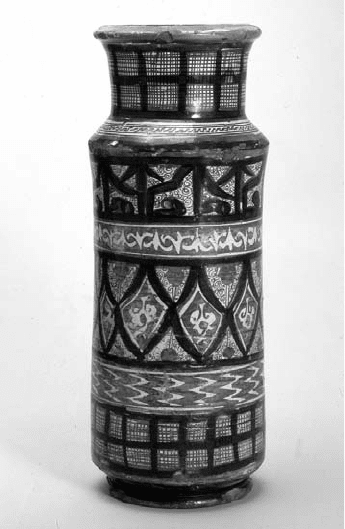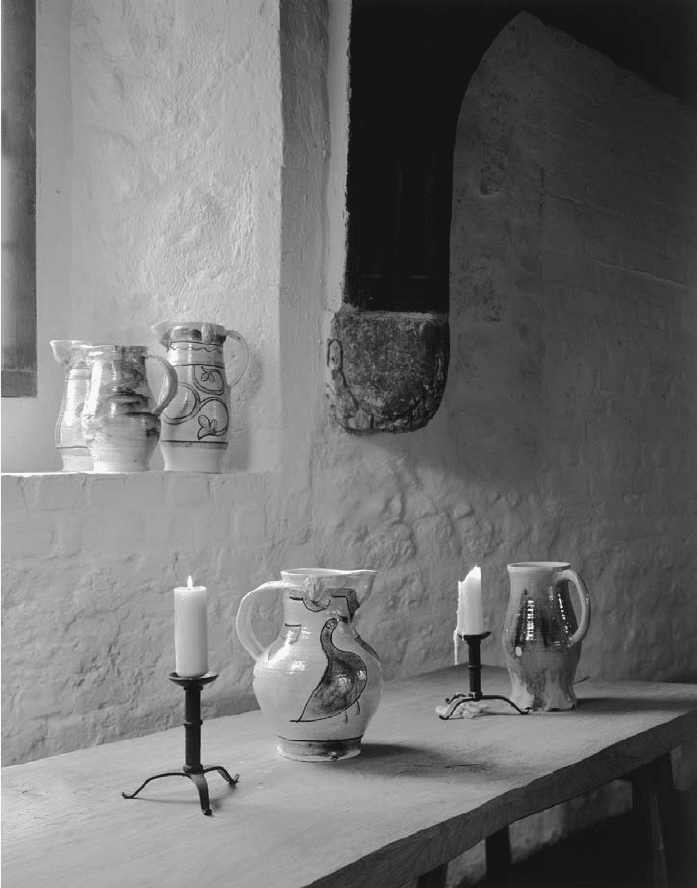Johnston R.A. All Things Medieval: An Encyclopedia of the Medieval World
Подождите немного. Документ загружается.

Pottery
580
a clear glaze. Minerals for slip painting produced the colors red, brown,
and black. Islamic ceramics with slip painting often have elaborate Koranic
inscriptions. Sometimes vessels fi rst decorated with slip painting had a col-
ored glaze, such as blue.
The last medieval ceramics techniques developed in the Islamic countries
were fritware and enamel painting. Fritware had large amounts of crushed
quartz mixed into the clay to make it both stronger and colored white.
Because of its strong composition, it could be decorated with relief carv-
ings, rather than enamel or other colors. Enamel painting was developed in
Iran; enamels were mineral glazes that could be painted onto glazed, fi red
dishes to add new colors and designs. They provided strong colors and
were painted with brushes, so potters could achieve good detail. The vessels
were then fi red again, at a low temperature. Persian enameled dishes had
a range of colors: blue, black, green, brown, red, white, and gold or silver
leaf. Islamic tile mosaics on buildings favor white, blue, and black because
of these techniques. Cobalt for blue was a commonly available mineral in
the Middle East.
European Pottery
The Islamic techniques came to the Mediterranean region fi rst, through
North Africa into Spain and through trade with Venice. At the same time,
the North Europeans had simple pottery methods they continued to use.
As with other crafts, northern and southern gradually blended by the 15th
century.
In Spain, two traditions competed and fi nally blended. The Christian
kingdoms in the north, based in Visigothic culture, used more primitive
pottery techniques, while Muslim Andalusia in the south imported pottery
and skills from Egypt. While northern potters were making simple gray pots
and pitchers, the Muslim potters of the south learned the Egyptian method
of making lusterware. Their twice-fi red pottery used crushed silver, cop-
per, or even gold in the second glaze. The metal adhered to the pottery
and made it shine. They also imported cobalt for blue glaze. The famous
blue and white wall tiles of the Alhambra palace were lusterware with co-
balt blue designs. The height of their art was showcased in the Alhambra’s
collection of large decorative vases covered with intricate designs based
on Arabic script.
When the Reconquest made most of the peninsula Christian again in
1248, Muslim potters altered their style to blend Christian and even Gothic
elements. They learned to paint heraldic designs. Many moved to the Va-
lencia region, and they exported ceramics all over Europe. The Valencia
style, by the close of the Middle Ages, used not just cobalt blue but also
other bright colors and had perfected the luster techniques. The Spanish
techniques and art were the dominant model for Italy.
Pottery
581
In early medieval Italy, the Roman techniques continued to be used,
although there was no further development under Gothic rule. Contact
with the Byzantine Empire renewed interest in glazes and decorating plain
wares. Most lead glazes turned yellow or green. The most common decora-
tion on a vase or jug was to draw a decoration in white slip on the red clay,
then scratch through the white slip to allow the red clay to show in lines,
and then coat it with a clear lead glaze, which turned yellow.
After 1250, pottery in northern Italy was often covered with white tin
glaze that allowed for much more decorative painting. By the end of the
Middle Ages, this decorated white pottery was called maiolica. The term
maiolica came from the Spanish island of Majorca, which served as a ship-
ping point for many tin-glazed wares that originated in Spanish Andalusia
and imported the tin-glazing technique from Baghdad. The clay vessels
were fi red in a kiln and then dipped in tin oxide glaze. After they dried,
the potter could paint designs using copper paint that would turn green
when refi red. When the vessel came out of the kiln, it was pure white with
green leaves or geometric designs. Maiolica pottery was very appealing and
became a major industry for Florence, Faenza, Orvieto, and other towns.
Although the term faenza came to stand for the style in Northern Europe,
each town tended to have a style of decoration that was distinctive: green
leaves in Florence, vines and grapes in Orvieto. As the 15th century passed
and Italy moved into the Renaissance period, potters developed more tinted
glazes and could paint in a variety of colors.
In Northern Europe, pottery was not as widely used. In the southern
regions that produced wine and olive oil, storage jars and pottery lamps
were much more important. Wood was the chief building material of the
north. In Southern Europe, pottery vessels all through the medieval period
included jars, pitchers, bowls, lamps, cooking pots, portable stoves, urinals,
trays, and funnels. Northern Europe used metal or wood for many of these
vessels and only maintained simple pottery techniques for pitchers, cups,
and some cooking pots until the pottery of the Mediterranean began to
make its way north through trade.
French pottery in the Middle Ages did not develop much until the 13th
century. Before that, they made basic jugs and jars glazed with green, yel-
low, and brown lead glazes. Norman pottery around Rouen used some
white slip decorations and relief designs. Tin glazing came fi rst to Avignon,
along the Mediterranean coast, from Italy. The potters began making white
tiles that they called faience, after the Italian city of Faenza.
In Flanders and the Netherlands, pottery was plain gray until they found
a deposit of red clay in the 13th century. With the red clay, they could
make white slip decorations similar to the Normans’ designs, and they dis-
covered colored glazes. Flemish pottery was soon in demand; they made
jugs and jars, cooking pots, and curfews (fi re covers to bank the ashes). Tin

Pottery
582
glazing came at the end of the medieval period, in the 15th century. The
Low Countries adopted the technology quickly; they began to produce
decorated white dishes to compete with imports from China. During the
postmedieval period, this industry became famous for its fi ne dishes, such
as delftware.
Most medieval English households used pottery only for pitchers, stor-
age jars in the kitchen, and drinking cups. Pottery cups were most fa-
vored by the poor who could not afford drinking horns, silver cups, or
even wooden tankards. Potters did not have guilds until the late Middle
Ages because making pottery was a part-time seasonal activity. After the
13th century, pottery had more status in England, and there were guilds.
By the 14th century, potters were making a wider variety of goods, from
bowls to cisterns.
The clay of England was typically red-brown; it was sometimes deco-
rated with white slip, as in Normandy. Most early pottery was not glazed.
The fi rst glazes used in medieval England were based on naturally occur-
ring lead powder, or galena, which was dusted onto the damp pot. The pots
turned yellow when fi red, or, if blended with copper, they turned green.
The few pitchers and mugs that survived into modern times are typically
bright, dark green and very shiny.
Beautiful maiolica pottery began with
Eastern tin glazing. After tin glazing
technology came to Spain, Italy, and
France, each region developed a style
unique to its tradition and aesthetic
sense. The style of Valencia, Spain, was
modeled on Islamic styles in Egypt and
Baghdad, and featured geometric
patterns. (Hermitage, St. Petersburg,
Russia/The Bridgeman Art Library)

After shaping a pitcher on the wheel and adding spout and handle, the potter could
use a different kind of clay as slip to make simple designs. Firing lead glaze over the
whole fi nished piece made it glossy and yellow. All of the pottery in a region looked
roughly the same, but the slightly different yellow, green, or brown decorations and
glazes made each ewer and vase unique. (English Heritage Images)
Pottery
584
English medieval pitchers were sometimes decorated with the fi gures of
animals or people pressed onto the upper shoulders of the pitcher. Pitch-
ers still extant today include decorations of dragons, birds, lions, ships,
and fi sh. Other pitchers were decorated with faces, often bearded, looking
outward. Water pitchers for table were sometimes made in the shape of ani-
mals or people so that the servants could pour water for guests from sheep
or horses. The jugs were carefully made in naturalistic animal shapes with
added handles, with the animal’s mouth as the spout.
Germany, like the rest of Northern Europe, at fi rst produced simple util-
ity vessels, either unglazed or fi red with lead. However, southern Germany
had a strong tradition of making highly decorated tiles that were used in
walls, fl oors, and stoves. This led Germany’s potters to innovate, and they
developed the only new ceramics inventions in Northern Europe.
The Rhine Valley potters invented stoneware, pottery that had been fi red
in unusually hot kilns until it had fused harder than most pottery and be-
came as hard as stone. The local clay was gray, with much sand in it, and it
was well suited to such high fi ring. It was generally not glazed in the medi-
eval period because the known glazes did not work at such high tempera-
tures. Stoneware was a popular export, and the Rhine River was a good
export waterway, so the industry developed in many river towns. Stoneware
did not make good cooking vessels, but it was good for storage jars and
bottles. It was particularly good for drinking cups. The new beer industry
was rapidly growing, and stoneware provided its pitchers and tankards.
In the 15th century, the Rhine potters developed salt glazing. They threw
salt into the kiln, and its vapors adhered to the pottery to produce a thin
glaze. Because the vapor produced such a thin glaze, the best way to deco-
rate the pottery was by pressing relief molds onto the surface, instead of
painting it. Early German salt-glazed vessels are usually covered with very
fi ne, beautiful molded decorations. The natural color of a salt-glazed vessel
depended on how much iron was in the clay as it reacted with the salt. The
clay around Aachen, in modern Belgium, fi red a rich reddish-brown with
salt. In Siegburg, the local clay fi red white.
See also: Bricks and Tile, Kitchen Utensils, Lead and Copper, Muslims.
Further Reading
Cooper, Emanuel. Ten Thousand Years of Pottery. Philadelphia: University of Penn-
sylvania Press, 2000.
Gaimster, David. German Stoneware, 1200–1900. London: British Museum Press,
1997.
Houkjaer, Ulla. Tin-Glazed Earthenware, 1300–1750. Copenhagen: Danish Mu-
seum of Art and Design, 2005.
Lewis, Griselda. A Collector’s History of English Pottery. Woodbridge, UK: Antique
Collectors’ Club, 1999.
Printing
585
Pancaroglu, Oya. Perpetual Glory: Medieval Islamic Ceramics from the Harvey B.
Plotnick Collection. Chicago: Art Institute of Chicago, 2007.
Poole, Julia E. English Pottery. Cambridge: Cambridge University Press, 1995.
Poole, Julia E. Italian Maiolica. Cambridge: Cambridge University Press, 1997.
Staubach, Suzanne. Clay: The History and Evolution of Humankind’s Relationship
with Earth’s Most Primal Element. New York: Berkley Books, 2005.
Printing
Books were handmade manuscripts until printing made mass production
possible. During the early 14th century, the fi rst printed books appeared.
Movable type had not yet been invented, but these books used woodcuts,
also called block prints. Flanders and the Netherlands region were the most ac-
tive areas in printing block books. The production of block books contin-
ued for many years even after the development of the printing press and its
key element, movable type.
Making a block print involved using a piece of wood and cutting away
the white space, leaving the surface of the block as the picture or letters.
The block was cut with the image reversed, left to right. When the artist
applied ink and pressed the block fi rmly down on paper, the image would
be correct. These block prints were probably originally designed to be hand
colored, but most remained as black-and-white images. Printers were able
to make use of color by applying red, blue, or even gold ink to an opening
initial or other decoration. Block printing was much faster than handwrit-
ing a manuscript, and the block could be used again and again, until the
pressure on the ink-wet wood fi nally caused it to wear out.
The earliest woodblock prints that we know of were used for religious in-
struction; they have woodcut pictures and hand-lettered text. Saints’ lives
and Bible stories dominated all medieval literature. Apocalypse was an im-
portant series of block books, with pictures telling the story from the last
book in the Bible, the “Revelation to Saint John.” Apocalypse was published
in at least six different editions. Another very infl uential block book was Ars
moriendi, “The Art of Dying.” It showed devils tempting the dying man
to lose his faith, and then angels helping him remain steadfast to the end,
in several scenarios of various temptations. Another widely known block book
was Incipit biblia pauperum, the Poor Man’s Bible. Each picture shows a
central scene from the life of Jesus, fl anked on the left and right by pictures
showing (respectively) Old and New Testament scenes or stories that teach
the same lesson.
Woodcuts allowed printers to manufacture playing cards. Cards became
popular, especially in Northern Europe, and card playing inevitably led
to gambling; German records from several cities indicate that gambling
Printing
586
became a huge problem and that cards were banned in the late 1300s.
There were also other kinds of cards that people gave to one another, an
early form of greeting cards.
By 1450, all of the needed materials and most of the necessary technol-
ogy were in place for the invention of printing. There were mills that could
supply paper in quantity. Artists had begun using oil-based paint, and an
ink that would work on metal type could be produced the same way. The
screw press, which produced the kind of fi rm and even pressure needed for
printing, was already in use for block printing on cloth and paper, among
its many uses. Goldsmiths knew how to do metal casting; they had stamp-
ing tools with small metal letters to imprint book covers and make coins.
The one requirement for printing that was not yet in place was the abil-
ity to make large quantities of metal type that was both moveable and reus-
able. The type needed to be small and must be cast so that each little letter
(a “sort”) would be on a perfectly square base to fi t tightly against other
letters. The type had to be reusable, and the sorts needed to be easily and
quickly made in the quantities necessary for a printed page. Two related
inventions also were needed: a tool that would hold the type while the printer
was assembling a line (a “compositor’s stick”), and a frame where the whole
page could be tightly assembled to go onto the press (a “chase”).
Johann Gutenberg of Mainz, Germany, was probably the fi rst printer
to solve all these problems. The primary work for which Gutenberg is known
is the Gutenberg Bible, commonly called the 42-line Bible. It was created
during the 1450s; from examining the details of the type, experts con-
clude that six compositors worked on the Bible, probably for at least two
years. The Gutenberg Bible was the fi rst major book produced with true
movable-type printing.
Trained as a goldsmith and metallurgist, Gutenberg set up a shop to
mass-produce souvenir mirrors for pilgrims going to a shrine at Aachen.
He also had a press on which he printed woodblock playing cards, among
other things, but he was working on developing movable type. In 1448, he
used a form of moveable type to produce a highly successful Latin grammar
textbook known as “the Donatus”—the name of its author, a monk and
scholar who lived in late Roman times. Using the same type, Gutenberg
printed one-page papal indulgences—in press runs of 200,000—for Pope
Nicholas V, who was trying to raise money for a Crusade to Cyprus. A few
copies of the indulgence are extant, as are some other very early printed
objects—a scrap of paper with a portion of a poem printed on it, a 1448
calendar that was printed with freshly cast metal type, and a Bible known
as the 36-line Bible.
During this time, Gutenberg also experimented with making a more ef-
fi cient press by combining elements from several kinds of industrial presses.
He probably had a fair-sized staff working for him on these projects,

Printing
587
including calligraphers, designers, pressmen, and metal workers. His major
contribution, however, was developing a handheld adjustable mold that
could make the thousands of small metal pieces of type—the sorts—that
were necessary for effi cient and fl exible printing.
To make a sort, the craftsman fi rst carved a letter in relief, in left-to-right
reverse, in the end of a steel punch. This process required several tools, in-
cluding fi les, a counter-punch, a graver (a small cutting tool), and a spe-
cialized graver (a scauper) to cut out the center of round letters. With a
hammer, the craftsman punched the letter into a soft copper blank to make
an impression called the matrix and fi led it smooth. He then inserted the
matrix into the handheld mold and used a small funnel to pour a mixture
of lead, antimony, and bismuth into the mold. This alloy was used because
it melted at a low temperature and also cooled rapidly. The fi nished letter,
on its square lead base, was dropped onto a tray to cool. The mold was ad-
justable so that thin letters like the small i or l had a thin base and larger
letters like M or W had a wide base. The mold also made special characters
like numbers, the dots used as punctuation, decorative capital letters, ab-
breviations, and ligatures.
An experienced worker could make four to six sorts a minute; this ef-
fi ciency made it possible for the shop to produce thousands of characters
in a day. In Gutenberg’s shop, the number of different characters was very
high; experts studying his printing have counted 290 alternate characters.
Gutenberg greatly admired handwritten manuscripts and wanted his books
to have that look. Therefore, he had his men make several versions of some
of the letters (for example, eight versions of lowercase e ) in a Gothic script,
The fi rst printing press used recently
developed screw-press technology.
To print one page, the printer had to
ink the sheet of type, load a paper into
the press, and turn the press’s screw.
The unique innovation of the process
was in casting lead letter dies that
could be melted down when they grew
dull and quickly recast. (Francis
Rolt-Wheeler, The Boy with the U.S.
Inventors, 1920)

Printing
588
with slight differences between them so the fi nished book would look
handwritten.
The fi rst step in printing a book was to set the type. The compositor
had to be an educated man, with a good grasp of grammar, spelling, Latin,
and even Greek. He sat in front of two cases where the sorts were kept in
compartments, capital letters in the upper case and little letters in the lower
case. (We still speak of letters as uppercase or lowercase.) As he read from
the manuscript, he placed the type line by line in a composing stick; each
fi nished line went into a galley (a shallow tray, open at one end), and the
fi nished page was locked into a chase.
The chase was then placed on the press stone (a large piece of marble)
and inked. The water-based ink that was used in manuscripts or for wood-
block printing was not suitable for printing with metal type because it
would not adhere to the metal. Printers developed a linseed oil varnish
similar to what artists had begun to use as oil paint. The ink used for the
Gutenberg Bible had a high metallic content of copper, lead, and titanium,
which made the ink somewhat refl ective, a quality it still has in extant
copies. To apply the ink to the type, the inker used two “hemispheres”
made of leather and equipped with handles. A hemisphere in each hand,
he dipped the leather into the ink and pressed it against the type, trying
not to splatter.
The night before printing, paper enough for the next day’s printing was
wet down and stacked to partially dry overnight. At printing time, the
moisture still in the fi bers made the paper absorbent enough to take the
Gutenberg’s fi rst movable-type press
produced many smaller works to
produce quick profi ts, but the
masterwork was the full Bible.
Gutenberg admired hand-copied
manuscripts and tried to preserve some
of their artistic style in his printing.
(Library of Congress)
Printing
589
ink. The press itself was like a vise with a screw mechanism that pressed
a plate (the platen) fi rmly down. It was an adaptation of the winepress,
enhanced by some features from textile and paper presses. After a page
was printed, it was set aside to dry, and another sheet of paper was placed
on the press. The sheets had more than one page printed on them, and
they had to be printed on both sides. Extremely careful planning was
needed for the pages to be correct when they were cut and folded into
quires (sections of the book). Decoration (colored initial letters and so
on) was done by rubricators. The fi nished cut and folded pages were
gathered into groups of pages and sent to be bound between leather-
covered boards.
Gutenberg’s invention revolutionized printing, and printers’ shops all
over Europe were soon using the new methods to meet the demand for
books. German printers particularly set up print shops in several other
countries, including England. It is estimated that between the invention of
printing and the end of the century, a period of only 45 years, more than
10,000,000 books were printed.
The fi rst printer in England was William Caxton, who published over
100 books during the late 15th century. Many of them were his own trans-
lations. Originally a wool merchant, he learned the printing trade in Co-
logne and set up a press in Bruges, where he printed the fi rst books in
English. When he returned to England, he brought eight fonts of Gothic
type and set up a printing shop of his own. His early published books in-
cluded Chaucer’s Canterbury Tales, Troilus and Criseyde, Malory’s Morte
d’Arthur, and many others. Caxton is equally well-known for editing some
of the books he published and for helping standardize the English lan-
guage through his publishing. He sought to follow what is known as the
Chancery Standard, a written form of English developed during the reign
of Henry V in the early 15th century.
See also: Alphabet, Books, Games, Parchment and Paper.
Further Reading
Hellinga, Lotte. William Caxton and Early Printing in England. London: British
Library, 2010.
Howard, Nicole. The Book: The Life Story of a Technology. Westport, CT: Green-
wood Press, 2005
Man, John. Gutenberg: How One Man Remade the World with Words. New York:
Wiley, 2002.
McMurtrie, Douglas C. The Book: The Story of Printing and Bookmaking. New
York: Oxford University Press, 1967.
Olmert, Michael. The Smithsonian Book of Books. Washington, DC: Smithsonian
Institution, 1992.
